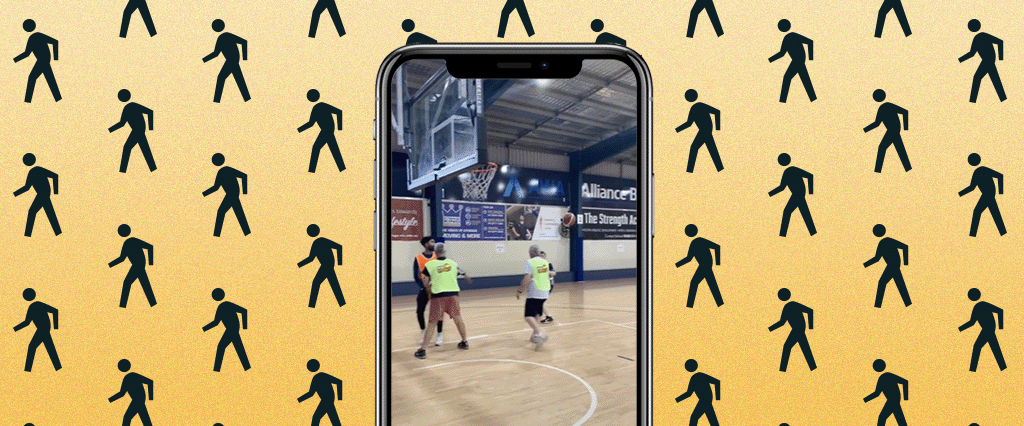It begins like so many beautiful basketball plays: A bounce pass to the high post from the top of the key, then a toss out to a man cutting toward the corner.
Without hesitation, he drives toward the baseline before tossing the ball out again, back to the free throw line, where a woman with silver hair awaits.
“Go!” someone yells.
She heaves a shot, but it clangs off the rim — wide left. Luckily, a hurried rebound attempt by an opponent ends up slapping the ball back to her teammate. In one smooth step, he gathers and throws the ball behind his back, passing it to an open man five feet away.
“Oooooh, the sauce!” a bystander hoots.
He faces up and buries a short jumper, then turns to his teammate and acknowledges the clutch assist with a clap of the hands and a finger-gun point, looking like Kobe. It’s a big play in a big moment, made even more novel by the fact that it’s happening at literal walking speed.
The scene is from a video clip that’s gone viral several times over in 2021, thanks to the wholesome joy of “walking sports” — a remix of basketball, football and soccer that restricts players to walking speed as they dribble and juke their way toward points.
The basketball footage is courtesy of Geelong United Basketball, an organization based in Australia that hosts a walking league. It’s one of a handful of groups around the world that host “walking” sport events, which mainly attract older participants who want to bathe in the glory of competitive sports without blowing out their knees in the process. And it’s a very nascent field: Perhaps the oldest organization is the Walking Football Association, founded in 2016 in the U.K. to provide anyone over 50 a chance to play soccer at an inclusive pace.
Nonetheless, the viral momentum in 2021 has been carried not by senior citizens, but by younger people who find a lot of laughs and highlight-reel moments by turning down the speed of their favorite plays. This is especially true with walking renditions of American football, which is now officially a meme thanks to the likes of Raiders quarterback Derek Carr and college football teams taking part.
On paper, watching a thicc offensive lineman juke someone out in sandals in a weight room doesn’t seem like a pulse-raising experience. And yet, in the clip filmed at Southern Nazarene University in Oklahoma, you hear the room explode with a roar of OHHHHHHHs and hyperactive shrieks from grown men. Such is the power of the walking sport: It may look silly, but the stakes still remain, and it’s a world in which a retiree can be as clutch as Jordan and a clever underdog can always win the fight.
Clearly, there’s demand for more walking sports, if the explosion of Britain’s Walking Football Association is any clue. There are now more than 1,100 clubs, with national and even international championship events held in recent years. Yet I couldn’t find a single organization in the U.S. that openly offers walking basketball or soccer, and it seems like most of the walking football (aka “walk ball”) action is happening with high school and college athletes.
It feels like a ripe opportunity, especially because of how “walking sports” could attract a hugely diverse group of people who may love watching sports but feel like they’re unable to participate, whether because of age, motivation or physical condition. Sadly, the vast majority of Americans quit sports by the time they’re teenagers, burned out on competitiveness and the pressure to develop and perform.
In a striking contrast, inclusivity has always been a core principle of walking sports. “We have obese players, those who have recovered from serious heart surgery, cancer and depression. It doesn’t matter what condition you are in physically or mentally, you can come along to play walking football and go away feeling good and with a smile on your face,” Paul Carr, founder of the Walking Football Association, said in 2018.
Everyone deserves to feel like Jordan, Messi and Moss from time to time, and research continues to show that participating in team sports can help mental health for both young and old alike. (And despite the seemingly low athletic ceiling of walking sports, it’s worth keeping in mind that walking is severely underrated as a legitimate workout, even if you exercise regularly.) Looking ahead, the possibilities extend beyond basketball, football and soccer — “walking” boxing or martial arts at half pace, anyone?
But whatever the case, it’s obvious that the unhurried joys of walking sports can, and should, be more than a temporary viral hit.

